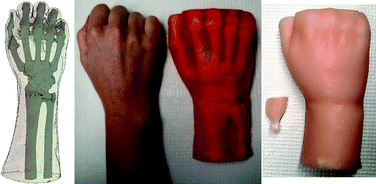Biomedical tissue phantoms with controlled geometric and optical properties for Raman spectroscopy and tomography†
Abstract
To support the translation of

* Corresponding authors
a
Department of Chemistry, University of Michigan, 930 North University Ave., Ann Arbor, USA
E-mail:
mdmorris@umich.edu
Fax: +1 (734) 763-0477
Tel: +1 (734) 763-0477
b Department of Internal Medicine, Rheumatology Division, University of Michigan Medical School, Medical Science Research Building II, Room 3560, 1150 West Medical Center Drive, Ann Arbor, USA
c Department of Orthopaedic Surgery, University of Michigan Medical School, 109 Zina Pitcher Place, Ann Arbor, USA
To support the translation of

 Please wait while we load your content...
Something went wrong. Try again?
Please wait while we load your content...
Something went wrong. Try again?
F. W. L. Esmonde-White, K. A. Esmonde-White, M. R. Kole, S. A. Goldstein, B. J. Roessler and M. D. Morris, Analyst, 2011, 136, 4437 DOI: 10.1039/C1AN15429J
To request permission to reproduce material from this article, please go to the Copyright Clearance Center request page.
If you are an author contributing to an RSC publication, you do not need to request permission provided correct acknowledgement is given.
If you are the author of this article, you do not need to request permission to reproduce figures and diagrams provided correct acknowledgement is given. If you want to reproduce the whole article in a third-party publication (excluding your thesis/dissertation for which permission is not required) please go to the Copyright Clearance Center request page.
Read more about how to correctly acknowledge RSC content.
 Fetching data from CrossRef.
Fetching data from CrossRef.
This may take some time to load.
Loading related content
